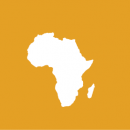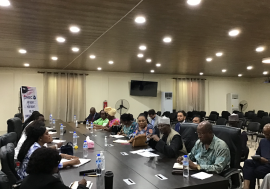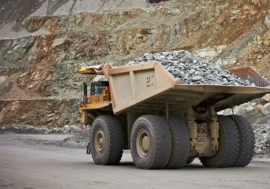UN Chief visits Africa’s Sahel region
UN Chief visits Africa’s Sahel region
Thursday, 7 November
Secretary-General visits in Chad
Facts about Chad
Population: 11 525 496
HDI Rank: 183/187
Workforce in agriculture: 66%
Recent emergencies: Sahel Crisis, locust, floods and meningitis outbreaks
Around 1,2 million people are food insecure in Chad. Women are particularly affected as they do not always have access to land for agricultural activities. Years of conflict in and around the country and recurrent climatic events have to high levels of displacement. The latter is considered a major driver of the humanitarian crisis, affecting around 622 000 people across Chad. This includes almost 350 00 refugees from the Sudan and Central Africa Republic, 131 000 displaced by internal conflict and 141 000 returnees primarily from Libya.
SG visits Burkina Faso
Facts about Burkina Faso
Population: 16 967 845
HDI Rank: 181/187
Workforce in agriculture: 92%
Recent emergencies: Sahel Crisis, floods, cholera and meningitis outbreaks.
In 2012, cereal food production fell by 20 percent compared to the previous year. Flooding affected over 150 000 people, destroying crops and killing livestock. More than half of rural households are poor, do not own land and have few animals, which are crucial source of nutrition and income. About 450 430 children under five are at risk of acute malnutrition. Burkina Faso hosts close to 35 750 refugees from northern Mali, who brought with them an estimated 50 000 animals.
UN Radio: Ban praises Burkina Faso efforts to achieve the anti-poverty goals

Secretary-General visits Niger (Wednesday, 6 November)
Facts about Niger
Population: 16 068 994
HDI Rank: 186/187
Workforce in agriculture: 83%
Recent emergencies: Sahel Crisis, locust, floods and cholera outbreak
In Niger, more than 3 million people are in state of chronic food insecurity, and their ability to withstand shocks is exhausted. Malnutrition rates have worsened between 2011 and 2012. Since fighting broke out in northern Mali in January 2012, more than 65 000 people have fled to the Niger. 2012 also saw unprecedented flooding, which affected more than 500 000 people.
See: UN, World Bank boost support for women’s health, girls’ education in Africa’s Sahel

Secretary-General visits Mali (Tuesday, 5 November)
Facts about Mali
Population: 15 835 389
HDI Rand: 175/187
Workforce in agriculture: 75%
Recent emergencies: Sahel Crisis, conflict, locust and floods.
Over the past two years, the conflict in the north destabilized the country and caused massive displacement (up to 200 000 IDPs and 200 000 refugees). In January 2013, a French-led military operation ousted terrorist groups from their strongholds. African-led forces, then a UN peacekeeping operation were deployed to help the country make its way back to stability. In a successful first step in that direction, presidential elections took place late in July. However, according to OCHA, at least 2 million people (half of them in the north) are food insecure and some 660 000 children are facing acute malnutrition. In 2012, over 4,6 million people were at risk of food insecurity in Mali. The 2011 droughts led to 41 percent decline in cereal production.
See: On UN-led visit to the Sahel region, global leaders pledge over $8 billion
UN Radio: Secretary-General and World Bank president head mission to Sahel // Listen
From 5 to 7 November, UN Secretary-General Ban Ki-moon is visiting Africa’s Sahel region. Along with the heads of the World Bank, the African Union Commission, the African Development Bank, and other officials, he will travel to Mali, Niger, Burkina Faso and Chad.
This visit is an opportunity for the UN chief to “hear concerns and priorities” of the region, Mr. Ban said late in September, speaking at the High-Level Summit he had convened on the Sahel. The visit is also an opportunity for the Secretary-General and other officials to highlight the needs of the Sahel -- Africa’s most vulnerable region – and to mobilize greater and better coordinated support for its people.
Africa Renewal is travelling with the Secretary-General and will bring you all about the visit, the Sahel and its challenges. For updates from the region, visit us here and follow us on Facebook: Africarenewal and Twitter: @Africarenewal
About the Sahel
The Sahel represents the southern edge of the Sahara desert, extending at least 4,500 km from Cape Verde through Senegal, Mauritania, Mali, Burkina Faso, Niger, and Chad. It is a transitional zone between the arid Sahara and the tropical green forest. The vegetation cover of the Sahel is composed of bushes, grasses and stunted trees. More than an eco-climatic zone, the term ‘Sahel’ also refers to a geopolitical entity. In 1973, nine west-African countries formed the Permanent Interstates Committee for Drought Control in the Sahel (CILSS). The CILSS ensemble covers approximately 5.7 million km2.
SAHEL current humanitarian situation
Total population: around 60 million
Refugees in need of assistance: 500,814
IDPs* in need of assistance: 318,558
Food insecure people in the Sahel: 11.7 million
Funding requested for the Sahel: US$ 1.71 billion
Funding requested per beneficiary: US$ 161
Funding received as of 25 October: US$ 866 million
Unmet requirement: US$ 841 million
Since its latest food crisis last year, Sahel has seen an improvement, following better rains and harvests. However, the effects of the crisis remain. Over 11 million people across the region continue to live in food insecurity. Five million children under five and pregnant or lactating women remain at risk of acute malnutrition, particularly in high risk areas such as Northern Mali and among Malian refugees in Burkina Faso, Mauritania and Niger. Cereal prices remain very high: in some areas as high as 50 per cent more than the five-year average. For more visit OCHA’s page http://www.unocha.org/crisis/sahel
What are the challenges facing the Sahel?
Africa’s Sahel region -- the continent’s most vulnerable region -- faces a range of complex and interconnected challenges: persisting food crisis, an environmental crisis, political and security instability and fragile economies. For more, read:
IRIN Sahel Page
http://www.irinnews.org/theme/sah/
Interview: “Business as usual doesn’t cut it”
Robert Piper, Humanitarian Coordinator for the Sahel















